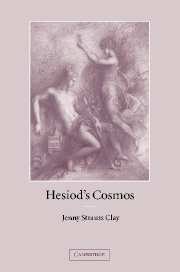Book contents
- Frontmatter
- Contents
- Preface
- Acknowledgments
- List of abbreviations
- Introduction
- 1 Orientations: the Theogony
- 2 Orientations: the Works and Days
- 3 Overtures
- 4 The origins and nature of mankind
- 5 The two Prometheuses
- 6 Perspectives on gods and men
- 7 Hybrids
- Conclusion: Hesiod and Calchas at Aulis
- Bibliography
- Indexes
Conclusion: Hesiod and Calchas at Aulis
Published online by Cambridge University Press: 04 August 2010
- Frontmatter
- Contents
- Preface
- Acknowledgments
- List of abbreviations
- Introduction
- 1 Orientations: the Theogony
- 2 Orientations: the Works and Days
- 3 Overtures
- 4 The origins and nature of mankind
- 5 The two Prometheuses
- 6 Perspectives on gods and men
- 7 Hybrids
- Conclusion: Hesiod and Calchas at Aulis
- Bibliography
- Indexes
Summary
Hesiod marks the beginning of his poetic career by his encounter with the Muses who, according to him, know “the things that are and those that will be and were before”. In the Theogony, through theMuses’ inspiration, he is enabled to sing “the things that will be and were before”, which I have interpreted not as past and future, but as that which has been and will be, in other words, that which is eternal and divine. Accordingly, the Theogony recounts how the everlasting gods and the other eternal constituents of the cosmos came into being. The cosmogonic process ends with the inauguration of the permanent and stable order under the sovereignty of Zeus, an order embracing the radiant abodes of the Olympians as well as the shadowy realm of the dark forces in the nether world. The human sphere, while not completely excluded, is viewed obliquely from the perspective of the divine. In the Works and Days, on the other hand, Hesiod claims to recount “things as they are,” ta etetuma (10), i.e. from the human perspective: the contingent nature of human life, its subjection to time and mortality, and the rules imposed by the eternal gods that regulate it. Each of these compositions on its own presents only a partial vision, but the study of both together makes manifest the whole, or Hesiod's cosmos, both the human and the divine.
The Muses are essential to the subject matter of the Theogony.
- Type
- Chapter
- Information
- Hesiod's Cosmos , pp. 175 - 182Publisher: Cambridge University PressPrint publication year: 2003



